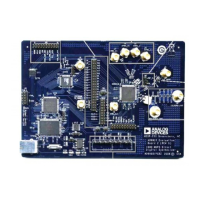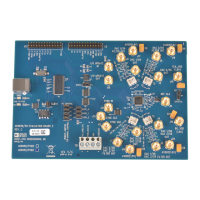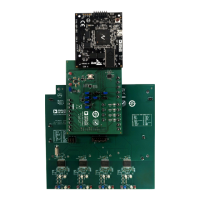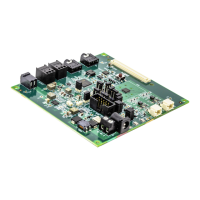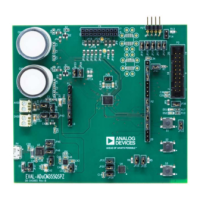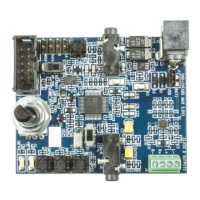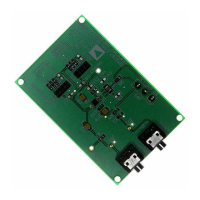AD9361 Reference Manual UG-570
| Page 113 of 128
SERIAL PERIPHERAL INTERFACE (SPI)
The SPI bus provides the mechanism for all digital control of
the AD9361. Each SPI register is 8-bit wide, and each register
contains control bits, status monitors, or other settings that
control all functions of the device. The following sections
explain the specifics of this interface.
SPI Functional Layer
The SPI bus can be configured by setting the bit values in the
SPI Configuration register. This register is symmetrical; that is,
D6 is equivalent to D1, and D5 is equivalent to D2 (D4 and D3
are unused). The device powers up in its default mode (MSB-
first addressing), but can accept an LSB-first write to the SPI
Configuration register because of this symmetry. The
symmetrical bits are OR’ed together, so setting one bit sets both
in the pair. The bit order is MSB-first when D5 and D2 are left
clear, while bit order is swapped to LSB-first when these bits are
set. Once properly configured, all subsequent register writes
must follow the selected format.
The bus is configured as a 4-wire interface by default. If Bit D6
and Bit D1are set, the SPI bus is configured as a 3-wire
interface. Bit D7 and Bit D0 asynchronously reset all registers to
their default values when set, and these bits must be cleared
before other registers can be changed.
Each SPI bus signal is described in the following sections.
SPI_ENB
SPI_ENB is the bus enable signal driven from the BBP to the
AD9361. SPI_ENB is driven low before the first SPI_CLK rising
edge and is normally driven high again after the last SPI_CLK
falling edge. The AD9361 ignores the clock and data signals
while SPI_ENB is high. If the AD9361 is the only device on the
SPI bus, SPI_ENB can be tied low.
The SPI_DO and SPI_DI pins transition to a high impedance
state when this input is high. If driven high during any
communications cycle, that cycle is suspended until SPI_ENB
is reactivated low.
SPI_CLK
SPI_CLK is the interface reference clock driven by the BBP to
the AD9361. It is only active while SPI_ENB is low. The
maximum SPI_CLK frequency is 50 MHz.
SPI_DI, SPI_DO and SPI_DIO
When configured as a 4-wire bus, the SPI utilizes two data
signals: SPI_DI and SPI_DO. SPI_DI is the data input line
driven from the BBP to the AD9361 and SPI_DO is the data
output from the AD9361 to the BBP in this configuration.
When configured as a 3-wire bus, SP_DI is used as a
bidirectional data signal that both receives and transmits serial
data. In 3-wire configuration, this signal is referred to as
SP_DIO in this section to distinguish between the two
configurations.
The data signals are launched on the rising edge of SPI_CLK
and sampled on the falling edge of SPI_CLK by both the BBP
and the AD9361. SPI_DI (or SPI_DIO) carries the control field
from BBP to the AD9361 during all transactions and the write
data fields during a write transaction. SPI_DO (or SPI_DIO)
carries the returning read data fields from the AD9361 to BBP
during a read transaction.
The AD9361 does not provide any weak pull-ups or pull-downs
on these pins. When SPI_DO is inactive, it is floated in a high
impedance state. If a valid logic state on SPI_DO is required at
all times, an external weak pull-up/pull-down should be added
on the PCB.
SPI Data Transfer Protocol
The AD9361 SPI is a flexible, synchronous serial communica-
tions bus allowing seamless interfacing to many industry
standard microcontrollers and microprocessors. The serial I/O
is compatible with most synchronous transfer formats,
including both the Motorola SPI and Intel® SSR protocols. The
control field width for the AD9361 is limited to 16-bit only, and
multibyte IO operation is allowed. The AD9361 cannot be used
to control other devices on the bus—it only operates as a slave.
There are two phases to a communication cycle. Phase 1 is the
control cycle, which is the writing of a control word into the
AD9361. The control word provides the AD9361 serial port
controller with information regarding the data field transfer
cycle, which is Phase 2 of the communication cycle. The Phase 1
control field defines whether the upcoming data transfer is read
or write. It also defines the register address being accessed.
Phase 1 Instruction Format
The 16-bit control field contains the following information:
MSB D14 D13 D12 D11 D10 D9:D0
W/Rb NB2 NB1 NB0 X X A[9:0]
W/Rb—Bit 15 of the instruction word determines whether a
read or write data transfer occurs after the instruction byte
write. Logic high indicates a write operation; logic zero
indicates a read operation.
NB2, NB1, NB0—Bits [14:12] of the instruction word specify
the number of bytes transferred during Phase 2 of the IO
operation. Table 52 details the number of bytes transferred
during Phase 2 for each NB[2:0] combination.
Table 52.
NB2, NB1, NB0 Description
000 Transfer 1 byte
001 Transfer 2 bytes
010 Transfer 3 bytes
011 Transfer 4 bytes
100 Transfer 5 bytes
101 Transfer 6 bytes
110 Transfer 7 bytes
111 Transfer 8 bytes
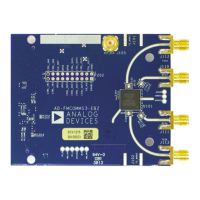
